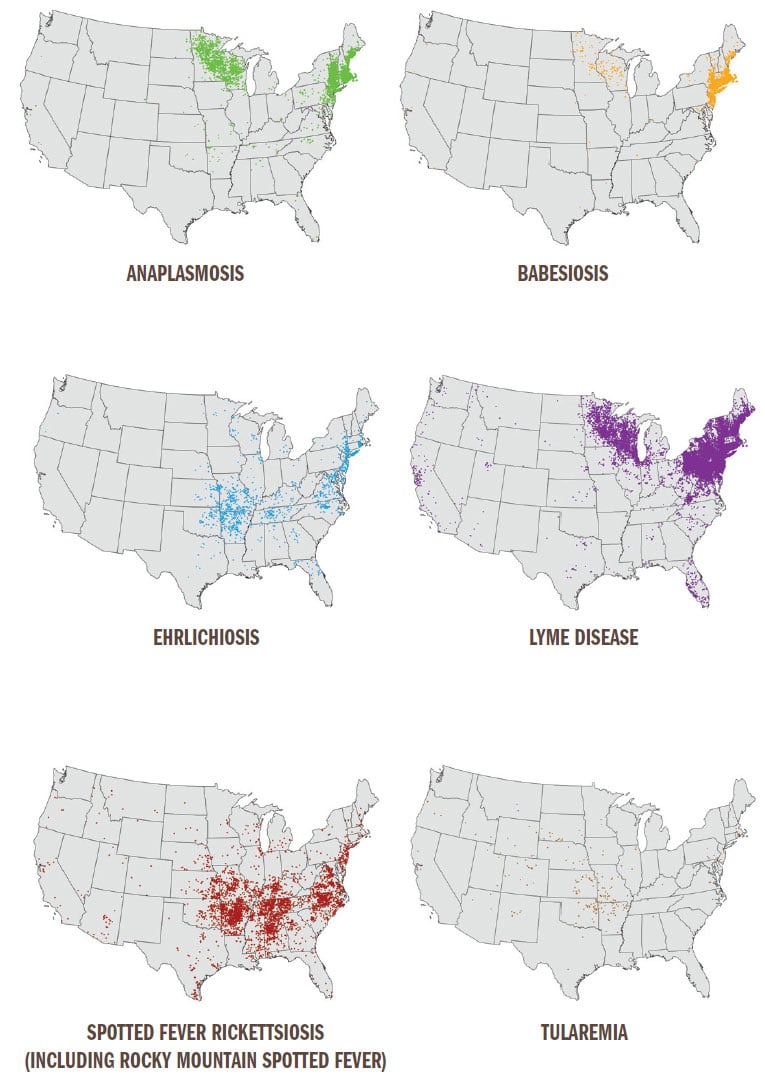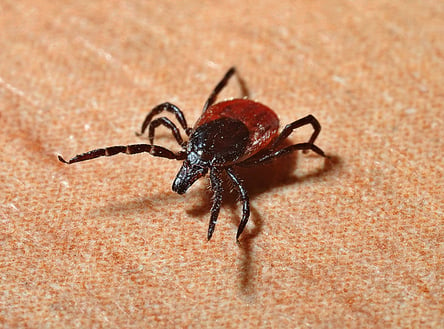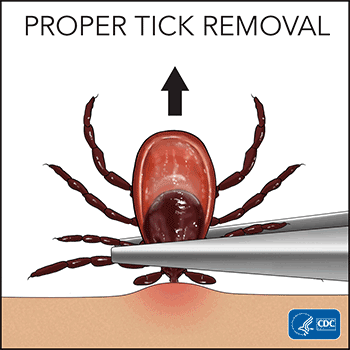Do I need to be worried about ticks?
Ticks are a big concern for our clients and residents of Doylestown, PA this year. The winter was mild in comparison to previous years, which resulted in a lack of natural tick elimination that typical freezing winters conduct. Historically, tick season begins when the weather warms up, and as spring progresses homeowners become more and more concerned with ticks biting their pets and family. Ticks can transmit diseases to humans and animals anywhere from a few minutes to a few days once attached to its host. For your protection, we’ve provided a snapshot of tick-borne diseases below so you can be prepared.

This diagram shows reported cases of each illness reported to the CDC in 2016. Each dot represents one case. As you can see, New Jersey and Pennsylvania both suffered from anaplasmosis, babesiosis, ehrilchiosis, Lyme disease, and spotted fever rickettsiosis in 2016.
Anaplasmosis
Deer ticks and black legged ticks are carriers of anaplasmosis and the associate bacteria. When humans contract anaplasmosis, they can suffer from symptoms that appear 1-2 weeks after being bitten such as fever, muscle pains, chills, severe headaches, confusion, hemorrhages, and renal failure. Dogs are also susceptible to anaplasmosis. In most cases, treated patients rapidly improve.
Babesiosis
Babesiosis is mainly transmitted by deer ticks and often referred to as a “malaria-like” disease. According to the American Lyme Disease Foundation, “Most patients experience a viral infection–like illness with fever, chills, sweats, myalgia, arthralgia, anorexia, nausea, vomiting, or fatigue. On physical examination, fever, splenomegaly, hepatomegaly, or jaundice may be observed.” In more mild cases, babesiosis will resolve on its own. However, more serious cases can pose long-term health implications.
Ehrlichiosis
Ehrlichiosis is caused by the ehrlichia bacteria and is primarily transmitted by the lone star tick. This illness can be contracted when the tick remains to feed on your skin for over 24 hours. Some people with strong immune systems may not even exhibit symptoms, and their bodies fight it off on their own. According to the Mayo Clinic, others will experience flu-like signs and symptoms usually with 7-14 days of the bite including mild fever, headache, chills, muscle aches, nausea, vomiting, diarrhea, fatigue, loss of appetite, joint pain, confusion, rash, and cough. Some more serious complications of untreated infection include kidney failure, respiratory failure, heart failure, seizures, and even going into a coma.
Lyme Disease
Lyme disease is arguably the most concerning and publicized tick borne disease. The only tick that carries the bacteria that causes Lyme disease is the blacklegged tick. Something important to note is that a blacklegged tick needs to be feeding on you for at least 24 hours before they can transmit Lyme disease. This is why it’s so important that you thoroughly check for ticks after spending time outdoors and if you do find one, remove it properly and right away. Symptoms of Lyme disease include:
- Erythema migrans rash- this is the classic bull’s-eye mark that is associate with Lyme disease
- Fever
- Chills
- Headache
- Fatigue
- Muscle and joint aches
- Swollen lymph nodes
For more reading on Lyme disease, click here.
Spotted Fever Rickettsiosis
The most serious of the spotted fevers is the Rocky Mountain spotted fever. Much like other tick borne illnesses, symptoms of Rocky Mountain spotted fever include fever, headache, rash, nausea, vomiting, stomach pain, muscle pain, lack of appetite, and rashes. If the illness is treated quickly, it’s likely to go away completely. According to the CDC, “Some patients who recover from severe RMSF may be left with permanent damage, including amputation of arms, legs, fingers, or toes (from damage to blood vessels in these areas); hearing loss; paralysis; or mental disability. Any permanent damage is caused by the acute illness and does not result from a chronic infection.”
How to Avoid Being Bitten By Ticks
Unfortunately, this year ticks are more active than usual, so we recommend that you take precautions before venturing into the great outdoors. When you take your dog for a walk, spend time in the park, or come in contact with tall grasses in any environment, you could be exposed to infected ticks. Even your yard can be a breeding ground for dangerous ticks.

The CDC provides a comprehensive guide to ticks, effects of tick bites, and tick prevention. “Steps to prevent Lyme disease include using insect repellent, removing ticks promptly, applying pesticides, and reducing tick habitat.” Below, we are going to explore these recommended methods and what you can do.
Insect Repellent
It’s recommended that you treat boots and clothing in products that contain the active ingredient permethrin. Spray all exposed skin with EPA-registered insect repellents containing DEET, and other approved chemicals.
Removing Ticks Promptly

Do not try to remove a tick by twisting, smothering it with petroleum jelly or Vaseline, squeezing, burning with a match or lighter, nail polish, or anything other than what the CDC recommends. Instead, you should use tweezers to grab the tick as close to the skin as possible and pull upward.
How can I get rid of ticks naturally?
According to the CDC, “Some insect repellent products for sale in the United States do not currently require EPA registration. In the 1990s, EPA evaluated the active ingredients in these unregistered products for safety (but not effectiveness). EPA determined that these all natural plant oils (like peppermint, thyme, eucalyptus, garlic, etc.) used in insect repellent products were safe for people and posed minimal risk to human health. EPA determined that products made from these all-natural ingredients do not require registration.”
This means that essential oils are approved as safe for skin application, but have not been tested by the EPA for effectiveness. Use extreme caution when relying on natural tick repellent and remedies to avoid ticks.
If you plan on venturing outside of your yard, choosing the proper tick repellent is paramount. Use the EPA’s repellent search tool to find the best repellent for you, factoring in things such as your length of time outdoors, the specific pest you need protection from, and more.
Where can I find tick control near me?
If you’re like most homeowners, you’re wondering, “Where can I find the best professional tick control service near me?”
The best way to find a quality pest control company that provides tick services are to know what to look for when considering a company. There are many companies that provide tick services for residential homeowners, and it is important to discuss the service with each company before committing to a seasonal tick service. Be sure to ask them about pesticide usage, service guarantees, service frequency, and their level of expertise when selecting the best pest control company to treat your yard for ticks.
What is a tick control program?
There are different types of tick control services; preventative and reactive. The reactive service will treat your entire lawn with pesticides which is not necessarily what homeowners would prefer, especially if they have pets and children who frequently use the yard. At Cooper, we offer a preventative tick program that was developed by our entomologists and is designed to specifically treat the ticks in your yard with less pesticide usage.
At Cooper, we believe that it’s better to prevent ticks than to eliminate them once they are biting your family and pets. When you are considering preventative tick services at your home, ask the other companies if they will target known tick breeding areas on your property, attacking the root of the problem. With continual treatments throughout the tick season, our customized plans can more effectively attack tick populations.
How much does tick control cost?
While we strongly recommend treating ticks before they become a problem, at Cooper, we can start treatments at any time during the spring and summer for homeowners in Doylestown, PA. Our full-season tick service begins in April and ends in the fall. By providing more staggered treatments throughout the season, we can proactively treat for ticks and then ensure reactionary treatments if needed are provided timely.
Cooper’s Tick Prevention Program is priced by the square footage of the area that is going to be treated. This means that pricing will vary between property size and amount of breeding and harborage areas that need to be serviced. The following areas taken in to account are listed below which can either increase or decrease the price with more or fewer areas.
- Wood Lines
- Field Lines
- High Grass
- Mulch Beds
- Dead Leaves
After determining the square footage of your property and all of the areas that need to be treated, our customized pricing is developed for your home. Depending on the month that service starts, you can have between 2 and 4 preventative treatments. We begin providing service for clients as early as April and as late as October with an average price of $75 per treatment. The professional tick inspectors at Cooper provide free tick inspections to residents in Doylestown, PA.
Give us a call at 1-800-949-2667 or visit our service page to schedule your free inspection today.

